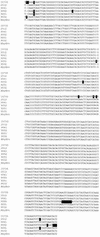Diverse and related 16S rRNA-encoding DNA sequences in prostate tissues of men with chronic prostatitis
- PMID: 9620394
- PMCID: PMC104894
- DOI: 10.1128/JCM.36.6.1646-1652.1998
Diverse and related 16S rRNA-encoding DNA sequences in prostate tissues of men with chronic prostatitis
Abstract
Treatment of chronic prostatitis/chronic pelvic pain syndrome is often empirical because clinical culture methods fail to detect prostate-associated pathogens in >90% of patients. Previously, we tested a variety of specific-microorganism PCRs and began a DNA sequence study after we found that 77% of prostatitis patients were PCR positive for prokaryotic rRNA-encoding DNA sequences (rDNAs) despite negative cultures using optimal techniques. In the present study, 36 rDNA clones from 23 rDNA-positive patients were sequenced. This study represents more than twice the total rDNA sequence and more than twice the number of patients in the previous study. The increased number of patients and clones sequenced allowed enhanced phylogenetic analyses and refinements in our view of rDNA species inhabiting the prostate. A continuum of related rDNAs that might be arbitrarily described as two major groups of rDNAs and several minor groups was found. Sequences termed Pros A, identified in 8 (35%) of 23 rDNA-positive patients, grouped with Aeromonas spp. in phylogenetic studies. Sequences termed Pros B, identified in 17 (74%) of 23 rDNA-positive patients, were distinct from previously reported sequences, although all were >90% similar to known gram-negative bacteria. Of the nine patients for whom multiple rDNAs were sequenced, six had biopsy specimens containing rDNAs from more than one species. Four (17%) patients had rDNAs different from those of the Pros A and Pros B groups. Of these four, one patient had rDNA similar to that of Flavobacterium spp., another had rDNA similar to that of Pseudomonas testosteroni, and two patients had rDNAs <70% similar to known rDNAs. These findings suggest that the prostate can harbor bacteria undetectable by traditional approaches. Most of these diverse sequences are not reported in environments outside the prostate. The sequence similarities suggest adaptation of limited groups of bacteria to the microenvironment of the prostate. Further studies may elucidate the relationship of prostate-associated bacteria to chronic prostatitis/chronic pelvic pain syndrome.
Figures



Similar articles
-
Prokaryotic DNA sequences in patients with chronic idiopathic prostatitis.J Clin Microbiol. 1996 Dec;34(12):3120-8. doi: 10.1128/jcm.34.12.3120-3128.1996. J Clin Microbiol. 1996. PMID: 8940458 Free PMC article.
-
Prostatitis: what is the role of infection.Int J Antimicrob Agents. 2002 Jun;19(6):475-9. doi: 10.1016/s0924-8579(02)00086-9. Int J Antimicrob Agents. 2002. PMID: 12135836
-
Bacterial dna sequences in prostate tissue from patients with prostate cancer and chronic prostatitis.J Urol. 2000 Oct;164(4):1221-8. J Urol. 2000. PMID: 10992370
-
Bacteria in the chronic prostatitis-chronic pelvic pain syndrome: molecular approaches to critical research questions.J Urol. 2002 Jun;167(6):2574-83. J Urol. 2002. PMID: 11992091 Review.
-
Prostatitis.Clin Microbiol Rev. 1998 Oct;11(4):604-13. doi: 10.1128/CMR.11.4.604. Clin Microbiol Rev. 1998. PMID: 9767058 Free PMC article. Review.
Cited by
-
Analysis of bacterial community using pyrosequencing in semen from patients with chronic pelvic pain syndrome: a pilot study.Transl Androl Urol. 2020 Apr;9(2):398-404. doi: 10.21037/tau.2020.02.05. Transl Androl Urol. 2020. PMID: 32420145 Free PMC article.
-
Characterisation of microbial communities within aggressive prostate cancer tissues.Infect Agent Cancer. 2017 Jan 13;12:4. doi: 10.1186/s13027-016-0112-7. eCollection 2017. Infect Agent Cancer. 2017. PMID: 28101126 Free PMC article.
-
Urinary microbiota in patients with prostate cancer and benign prostatic hyperplasia.Arch Med Sci. 2015 Apr 25;11(2):385-94. doi: 10.5114/aoms.2015.50970. Epub 2015 Apr 23. Arch Med Sci. 2015. PMID: 25995756 Free PMC article.
-
[Acute prostatitis associated with noncancerous prostate at the Lubumbashi University Clinics: epidemioclinical and therapeutic features].Pan Afr Med J. 2020 Dec 1;37:290. doi: 10.11604/pamj.2020.37.290.21260. eCollection 2020. Pan Afr Med J. 2020. PMID: 33654514 Free PMC article. French.
-
A hemizygous short tandem repeat polymorphism 3' to the human phosphoglycerate kinase gene.Mol Biol Rep. 1999 Aug;26(3):159-65. doi: 10.1023/a:1006908624757. Mol Biol Rep. 1999. PMID: 10532310
References
-
- Amann R, Springer N, Ludwig W, Gortz H, Schleifer K. Identification in situ and phylogeny of uncultured bacterial endosymbionts. Nature. 1991;351:161–164. - PubMed
-
- Archer B J, Holm R P. Treatment of Aeromonas hydrophila infection in a deep tissue wound. S D J Med. 1995;48:405–407. - PubMed
-
- Berger R E, Krieger J N, Kessler D, Ireton R C, Close C, Holmes K K, Roberts P L. Case-control study of men with suspected chronic idiopathic prostatitis. J Urol. 1989;141:328–331. - PubMed
-
- Bowie W. Urethritis in males. New York, N.Y: McGraw-Hill; 1990. p. 356.
-
- Bruce A W, Chadwick P, Willett W S, O’Shaughnessy M. The role of chlamydiae in genitourinary disease. J Urol. 1981;126:625–629. - PubMed
Publication types
MeSH terms
Substances
Grants and funding
LinkOut - more resources
Full Text Sources
Miscellaneous

